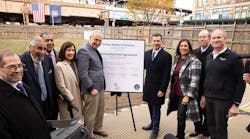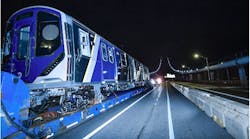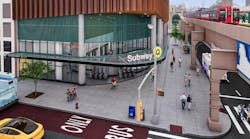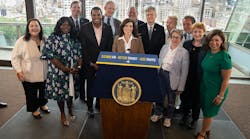OP-ED: FTA, MTA $7.7 billion Second Avenue Subway Phase 2 Full Funding Grant Agreement real deal
There is more to the signing of a Federal Transit Administration (FTA) Capital Investment Grant (CIG) Full Funding Grant Agreement (FFGA) with Metropolitan Transportation Authority (MTA) for financing the $7.7 billion Second Avenue Subway Phase 2 project. Allow a former FTA Region 2 New York Office of Operations and Program Management Director to provide a more comprehensive review.
How can MTA Chairman Janno Lieber legally sign off and commit to providing $4.3 billion in local share when most of these dollars are not real? The MTA local share of Fiscal Year (FY) 2023 $653 million and FY 2024 $612 million are dependent, for the most part, on future initiation of Congestion Price Tolling revenue. The MTA is also committed to provide $378 million each year from FY 25 up to FY 32. How can the MTA make such a legal commitment for this time period when the MTA Board, State Legislature and governor have not submitted, reviewed or approved the next 2025 - 2029 and 2030 - 2034 Five Year Capital Plans?
Lieber reminds me of Rod Tidwell in the 1996 movie "Jerry Maguire," who said "Show me the money!" Any FTA $3.4 billion funding as part of the $7.7 billion future CIG FFGA has some significant risk for the recipient. MTA must accept the terms and conditions within the grant offer. FTA caps its funding at $3.4 billion. MTA becomes legally responsible for both the local share along with any cost overruns above and beyond the agreed upon project cost. The FTA will not increase its share.
Congestion Pricing may not be implemented until June 2024. There is no guarantee that anywhere near $1 billion in annual toll revenues will appear. You can't capture five years of toll revenues estimated to be $1 billion per year when you implement the program 4.5 years late or after 90 percent of the MTA $51 billion Five Year 2020 - 2024 capital program has come and gone. The MTA Traffic Mobility Review Board still needs to determine who will pay how much in tolls for those driving south of 60th St. in Manhattan and 120 various constituencies have requested exemptions or reductions. Some New Jersey elected officials have filed federal legislation or law suits to prevent the MTA from initiating Congestion Pricing.
A significant shortfall in anticipated Congestion Pricing revenues has adverse consequences. The MTA will have to choose between preserving $4.3 billion local share for meeting legal requirements as part of the FTA $7.7 billion Second Avenue Phase 2 FFGA or postponing several billion in routine operating agencies safety and state of good repair projects. The devil is in the hidden details as to which projects and programs the MTA would postpone.
How can the MTA justify spending $3,4 billion for construction of three stations at 106th, 116th and 125th st.'s? They may be the most expensive new subway stations in MTA history. The same is true for FTA funding of any stations within other CIG FFGA New Starts project nationwide.
MTA intends to provide service 24 hours a day, seven days a week in both the opening year and the horizon year, with trains every three minutes during peak periods, every five minutes on weekday off peak and evening periods and every six minutes on weekends. The Revenue Service Date is Sept. 30, 2032.
Doesn't this require the purchase of additional subway cars? Why is this missing from the FFGA? To meet the promised service requirements, New York City (NYC) Transit might need up to three trains traveling north bound to serve three new stations, plus turn around time at 125th St., three trains south bound, plus a seventh train held back in the yard as a spare.
The most recent subway car purchase was a $1.4 billion contract award in early 2020 to Kawasaki Rail Car for the purchase of 535 new R211 subway cars The cost was $2.7 million per vehicle. To purchase seven additional 10-car train sets later this decade between inflation, market conditions and other factors will easily result in a new price of between $3 and $3.5 million per car. This is needed to meet the September 2032 start of revenue service date.
Why do MTA Chairman Lieber, Sen. Charles Schumer (D-NY), New York Gov. Kathy Hochul, Rep. Adriano Espaillat (D-NY-13) and other elected officials claim this project will mitigate East Harlem being a transit desert? Are they not aware there are already an extensive network of north/south and east/west local bus routes, several stations on the Lexington Avenue subway line and the MTA North 125th St. Station?
In addition, there is the M15 Select Bus Service route. This is a limited stop style express service running on dedicated bus lanes. The route runs downtown on 2nd Ave. and uptown on 1st Ave. between 125th St. and South Ferry. Fares are collected at bus stops prior to boarding. Thousands of East Harlem residents use these options on a daily basis. A bus stop is never more than a block or two walk away, A subway stop is never more than up to 10 blocks away. Using the concepts of "transit deserts" and "transit equity" as justifications to advance projects have crept into main stream acceptance with no questions asked.
How many project contracts will there be? What are the milestones for bid specification development, advertising, responses to bidders questions, receipt of bids, opening and review of bids followed by contract award? How much float time has been built into the master project schedule for both the procurement process, construction, inspection and acceptance, receipt of maintenance manuals for each asset worth over $5,000 (as required by FTA), completion for each contract punch list followed by release of retainage for each contractor to meet the promised September 2032 revenue service date?
What will the DBE goals be for the overall project and each contract? Will the MTA be transparent and post on their website all monthly FTA Project Management Oversight Independent Engineering Monthly reports so commuters, taxpayers, local community planning board members, elected officials and others are aware of concerns and issues raised by the federal funding agency?Will MTA do the same with all draft and approved grant amendments, any future amendments to the FFGA and Quarterly Grant progress reports submitted to FTA?
As part of the requirements contained within all master grant agreements, using the FTA TrAMS System, the MTA provides updated Quarterly Financial and Milestone Progress Reports to the FTA on active capital improvement projects and programs. These are required to be submitted within 30 days after the fiscal quarter has started on the first of the month and ends on the last day the third month. Federal fiscal quarters are October - December, January - March, April - June and July - September.
How will MTA deal with potential future integration to progress any future extension west on 125th St. beyond the Phase 2 Lexington Avenue station? Has the Second Avenue Subway Phase 2 project been added to the annual NYC Transit Force Account and Track Outage Plans? Are the additional rail cars needed for revenue service included in the NYC Transit Fleet Management Plan?
Will the MTA make public the Project Management Plan reviewed and approved by FTA? This critical document demonstrates the MTA has the technical capacity to advance this project from start to finish.
Will the MTA make public the Financial Capacity Assessment that documents just how the MTA has adequate financial capacity to both carry out this project and cover annual operating costs upon completion?
Commuters, taxpayers, transportation advocacy groups, project advocates, local elected officials and East Harlem community planning board members deserve answers to these questions.
Otherwise, buyer beware!

Larry Penner
Larry Penner is a transportation advocate, historian and writer who previously served as a former director for the Federal Transit Administration Region 2 New York Office of Operations and Program Management. This included the development, review, approval and oversight for billions in capital projects and programs for New Jersey Transit, New York Metropolitan Transportation Authority, NYC Transit bus, subway and Staten Island Railway, Long Island and Metro North railroads, MTA Bus, NYCDOT Staten Island Ferry along with 30 other transit agencies in New York and New Jersey.






